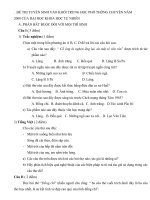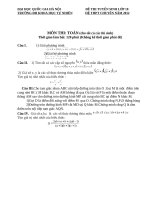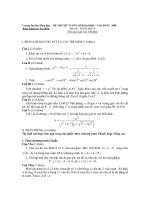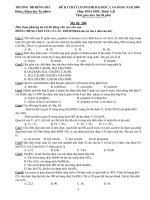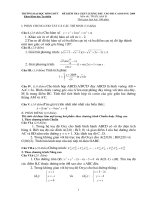Science Process Skills G3 SE_Sách khoa học tự nhiên
Bạn đang xem bản rút gọn của tài liệu. Xem và tải ngay bản đầy đủ của tài liệu tại đây (93.15 MB, 551 trang )
A page like the one below is found near the beginning of each chapter.
It shows you how to use a reading skill that will help you understand
what you read.
Before Reading
Before you read the chapter, read the Build Background page and
think about how to answer the question. Recall what you already
know as you answer the question. Work with a partner to make a list
of what you already know. Then read the How to Read Science page.
Target Reading Skill Compare and Contrast
Each page has one target When you compare things, you tell how they are alike.
reading skill. The reading When you contrast things, you tell how they are different.
skill corresponds with a • Words and phrases such as similar, like, all, both, or in
process skill in the Directed
Inquiry activity on the facing the same way are clues that things are being compared.
page. The reading skill will be • Words and phrases such as different, unlike, or in a
useful as you read science.
different way are clues that things are being contrasted.
Real-World Connection
Each page has an example of Magazine Article
something you might read. It
also connects with the Directed Ben and Misha both collect rocks. Ben prefers
Inquiry activity. brightly colored rocks. He is a member of a
rock hunters club that goes on collecting trips.
Graphic Organizer Misha has a different way of collecting his
A useful strategy for favorite kinds of rocks—fossil rocks. His uncle sends Misha
understanding anything you fossil rocks from all around the world. Unlike Ben, Misha just
read is to make a graphic has to make a trip to his mailbox to add to his collection.
organizer. A graphic organizer
can help you think about the Apply It! Different Alike Different
information and how parts of
it relate to each other. Each You can use a Ben Misha
reading skill has a graphic graphic organizer
organizer. as a model to show
how things compare
xx and contrast.
Use a graphic organizer to show ways that Ben and Misha
are alike and different in the way they collect rocks.
197
Properties of Minerals
Mineral Color Luster Streak Hardness
Mica black, pearly on white can be Test Prep
Mica breaks gray, surfaces scratched
into flaky green, with a knife Choose the letter that best completes the
pieces violet statement or answers the question.
when struck. 13. Predict Which would dry faster
silvery metallic bluish can be after it rains: a sandy beach or 17. All rocks contain
Molybdenite gray scratched a grassy field? Give a reason for A loam.
This mineral is with a your answer. B minerals.
one of the fingernail C water.
strongest and 14. Model Make a model or a D sediments.
most commonly reddish- very orange- can be drawing that shows the different
used heat-resistant orange shiny yellow scratched layers of soil. 18. In what rocks are fossils most
metals. with a often found?
coin 15. Infer You observe that a mineral F sedimentary
Crocoite sample can be scratched with a G igneous
Much of this coin. What do you infer about the H metamorphic
mineral hardness of the mineral? I all of the above
comes from
Australia. 19. The layer of soil just below the
topsoil is
Another way to identify a mineral is to test its hardness. Compare A loam.
Some minerals, such as talc, are so soft you can scratch and Contrast B decayed matter.
them with your fingernail. The hardest mineral is diamond. C rock.
It can be scratched only by another diamond. 16. Make a graphic organizer like D subsoil.
the one below. Fill it in to compare
Some minerals can be identified by their appearance. and contrast sandy soil and 20.
Gold, for example, appears sometimes in nugget form. clay soil. Persuasive Write a letter to
Other minerals can be identified by taste, smell, or touch. a member of a city council that
Sandy Both types Clay discusses why rich farmland
soil of soil soil is valuable to everyone in the
community.
1. What are ways to identify minerals?
2. Compare and Contrast How are rocks and minerals
alike? How are they different? Use a graphic organizer to show
your answer.
203 215
During Reading After Reading
As you read the lesson, use After you have read the chapter,
the Checkpoint to check your think about what you found out.
understanding. Some Exchange ideas with a partner.
checkpoints ask you to Compare the list you made
use the target reading skill. before you read the chapter with
what you learned by reading
it. Answer the questions in the
Chapter Review. One question
uses the target reading skill.
Graphic Organizers
These are the target reading skills that appear with their graphic organizers.
Cause and Effect Draw Conclusions
Compare and Contrast
Sequence Summarize
Predict Main Idea
and Details
Make Inferences
xxi
Scientists use process skills when they
investigate places or events. You will use
these skills when you do the activities in this
book. Which process skills might scientists
use when they investigate weather?
A scientist who studies
weather observes
many things. You use
your senses too to
find out about other
objects, events, or
living things.
Scientists classify
clouds according
to their properties.
When you classify,
you arrange or sort
objects, events, or
living things.
Scientists estimate how
much rain will fall. Then
they use tools to measure
how much rain fell.
xxii
Scientists infer what they
think is happening during
a storm, based on what
they already know.
Scientists predict how
weather will change.
Then people know how
to get ready for the
change.
Scientists make and
use models such as
pictures and maps.
Models are like real
events in some ways,
but are different in
other ways.
Scientists can use what
they know to make
operational definitions
about what they observe
during a storm.
xxiii
Think of a statement If you were a scientist, you might want to
that you can test to learn more about storms. What questions
solve a problem or might you have about storms? How would
answer a question you use process skills in your investigation?
about storms or other
kinds of weather.
As scientists
observe storms,
they investigate and
experiment to test a
hypothesis.
As scientists perform an
experiment, they identify
and control the variables
so that they test only one
thing at a time.
xxiv
Scientists collect data
from their observations
of weather. They put
the data into charts or
tables.
Scientists use the
information they
collected to solve
problems or answer
questions.
Scientists use words,
pictures, charts,
and graphs to share
information about their
investigation.
xxv
Scientists use scientific methods as they work. Scientific methods are
organized ways to answer questions and solve problems. Scientific methods
include the steps shown here. Scientists might not use all the steps. They
might not use the steps in this order. You will use scientific methods when
you do the Full Inquiry activity at the end of each unit. You also will
use scientific methods when you do Science Fair Projects.
Ask a question. What material is
You might have a question best for keeping
about something you observe. heat in water?
State your hypothesis.
A hypothesis is a possible
answer to your question.
If I wrap the jar in fake
fur, then the water will
stay warmer.
Identify and Test other materials. Put the same
control variables. amount of warm water in other jars
Variables are things that are the same size and shape.
that can change. For
a fair test, you choose
just one variable to
change. Keep all other
variables the same.
xxvi
Test your hypothesis.
Make a plan to test your hypothesis. Collect
materials and tools. Then follow your plan.
Collect and record your data.
Keep good records of what you do and find out.
Use tables and pictures to help.
Interpret your data.
Organize your notes and records to make them
clear. Make diagrams, charts, or graphs to help.
State your conclusion.
Your conclusion is a decision you make
based on your data. Communicate
what yAotmuofsopuhnedreout. Tell whether or not
your data supported your hypothesis.
Fake fur did the best job of
keeping the water warm.
Go further.
Use what you learn. Think of new questions
to test or better ways to do a test.
xxvii
cientists use many different kinds of tools. Tools can
make objects appear larger. They can help you measure
volume, temperature, length distance, and mass. Tools can
help you figure out amounts and analyze your data. Tools
can also help you find the latest scientific information.
You should use
safety goggles to
protect your eyes.
You use a thermometer You can use a telescope to
to measure temperature. help you see things that are
Many thermometers have very far away, such as stars
both Fahrenheit and Celsius and planets.
scales. Scientists usually
use only the Celsius scale. A hand lens
doesn’t enlarge
Binoculars make things as much as
far-away objects a microscope does,
appear larger, so but it is easier to
you can see more carry.
of their details.
xxviii
Scientists use rulers and
metersticks to measure
length and distance.
A balance like this
one can be used to
measure mass.
Microscopes use
several lenses to make
objects appear much
larger, so you can see
more detail.
xxix
Magnets can be
used to test if an
object is made
of certain metals
such as iron.
Pictures taken with a camera
record what something looks
like. You can compare pictures
of the same object to show how
the object might have changed.
A graduated cylinder Calipers can be
can be used to measure used to measure the
volume, or the amount of width of an object.
space an object takes up.
You can figure
amounts using
a calculator.
Scientists use
computers in
many ways, such as
collecting, recording,
and analyzing data.
You can talk into a
sound recorder to
record information you
want to remember.
xxx
A spring scale measures
the force of gravity on
an object. It is a type
of force meter.
Clocks and
stopwatches
are used for
measuring time.
Hot plates are often used
by scientists as a heat source
in experiments.
Collecting nets are used A microscope uses several lenses to
by scientists who study living make objects appear much larger, so
things. They are used to collect you can see more detail.
organisms.
xxxi
ou need to be careful when doing science activities.
This page includes safety tips to remember:
Listen to your teacher’s instructions.
Read each activity carefully.
Never taste or smell materials unless your teacher
tells you to.
Wear safety goggles when needed.
Handle scissors and other equipment carefully.
Keep your work place neat and clean.
Clean up spills immediately.
Tell your teacher immediately about accidents
or if you see something that looks unsafe.
Wash your hands well
after every activity.
xxxii
ways parts of a plant help it survive.
different types of plants.
different ways plants make more plants.
that plants have changed over time.
1
system
coniferous
pollinate seed leaf
2 germinate
deciduous Chapter 1
Vocabulary
system page 8
deciduous page 14
pollinate page 15
coniferous page 16
seed leaf page 20
germinate page 20
seedling page 20
fossil page 22
extinct page 23
seedling fossil
extinct
3
Explore How are plants alike and different?
Materials What to Do
grass
Observe each plant with
a hand lens. Notice the
characteristics of their leaves
and roots.
radish root
hand lens
Look for the places where
the leaves grow from the
stems of the plants.
Look at the roots that grow from
the stems of the plants.
You used your root
observations to
explain how the Explain Your Results
plants are alike
and different. Use what you observed to explain how
the two plants are alike and different.
4
Compare and Contrast
Knowing how to compare and contrast can help you
understand what you read and the things you observe.
• We compare when we say how things are alike.
We contrast when we say how things are different.
• Words and phrases such as similar, like, all, both,
or in the same way are used to compare.
• Words and phrases such as unlike or in a different
way are used to contrast.
Science Article
Both plants and animals are living things
that need food, air, water, and space to live.
Unlike most plants, most animals don’t stay
in the same place. They move around. Unlike
animals, most plants have roots that keep them
in the same place.
Plants Both Animals
Ways that plants Ways that Ways that animals
are different plants and animals are different
from animals from plants
are alike
Apply It!
Make a graphic organizer like the one shown. Use the
information from the science article to fill it in.
5
It’s a cool spring day and you are walking
along a river in Alaska. Tall trees rise above
the river. Why do some have flat, broad
leaves, while others have sharp needles? Lots
of other kinds of plants are growing here too.
Even though they may look different, every
plant needs the same things to live and grow.
Listen. You hear a splash. An Alaskan brown
bear bounds out of the trees into the river.
The bear needs certain things too.
6
Lesson 1
What are the main
parts of a plant?
Most plants have four main parts. These parts are
leaves, roots, stems, and flowers. In different kinds of
plants, these parts may look similar. They may also
look very different.
What All Living Things Need
Most living things, including plants and
animals, need food, air, water, and space to live
and grow. Animals find and eat plants or other
animals to get their food. Unlike animals, plants
can make their own food. To make their food,
plants need energy from the Sun. Most plants
also need soil.
Most plants have four
main parts. These parts
are leaves, roots, stems,
and flowers.
Black-eyed Susans are
one of the many plants
you might see in a prairie.
1. What do
plants and animals need to live?
2. Descriptive
Choose an animal and a plant and describe in your
science journal what each needs to survive.
7



